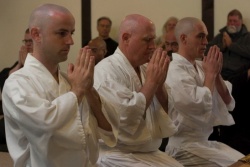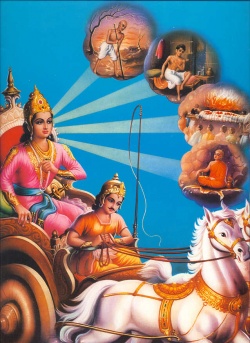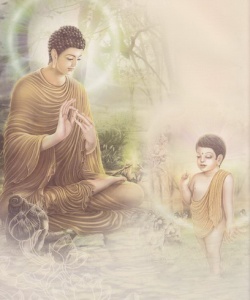The First Jhāna (Paṭhama Jhāna)
The standard jhāna formula in the context of the development of meditative composure through mindfulness of breathing (ānāpānassatisamādhi) is stated in SN 54.8 Padīpopama Sutta:
Therefore, monks, if a monk wishes, “May I, quite secluded from sensual pleasures, secluded from unskillful phenomena, enter and remain in the first jhāna, which includes directed thought and evaluation, as well as joy and pleasure born of seclusion,” this same meditative composure through mindfulness of breathing should be closely attended to.
The progression from focusing on the internal felt-sense of the body to focusing on the arisen mental factor of joy (pīti) and bodily pleasure (sukha) represents our movement toward and into the first jhāna. As this is a subjective experience, the mental and bodily qualities that we’re about to discuss will vary somewhat from person to person and even from sitting to sitting. Nevertheless, there are some general indicators that we can become aware of as we progress from a discursive mind involved in external sensory impingement, to a unified mind characterized by internal happiness and well-being, and beyond that, an experience of serene tranquility.
While the phenomenal factors of joy and pleasure may seem to be similar, there are subtle and distinctive differences that we can become aware of. And as joy (pīti) is the coarser of the two qualities, we first turn our attention to it.
Remaining unified with the entire internal felt-sense of the body, experienced in its totality, we begin to focus on the mental quality of joy when it arises. This joy is mental (i.e. not bodily) and is more than just the bare mental feeling (vedanā) of pleasure associated with the contact between the settled mind and the inner body sphere. Synonyms for this joy include: gladness (pāmojja), delight (āmodanā), joyfulness (pamodanā), shining mirth (bhāsa pabhāsa), felicity (vitti), elation (odagya), satisfaction (attamantā), and mental uplift (cittassa).1
So what we’re talking about here is an affective mental quality that can range from a sense of internal satisfaction (openness and joyous ease) to ecstatic bliss. Again, the experience will vary from occasion to occasion and person to person. But whatever this quality is for each of us individually, it arises as a direct result of the unification of mind with the inner felt-sense of the entire body. There’s nothing necessarily ecstatic or blissful about this experience. The mind simply enjoys paying attention to the body and being free from the hindrances and all associated worldly concerns. By breathing mindfully, paying attention and surrendering to the whole felt-sense of the body, and thereby allowing the breath to calm itself, a sense of ease, lightness, and happiness spontaneously arises. It’s the basic goodness of not being preoccupied by any concerns, which then leads to a sense of openness and joy as the mind continues to settle.
That said, powerful experiences of ecstatic bliss and profoundly delightful experiences of the heart area spontaneously opening and being saturated with feelings of universal love, or strong vibrational currents within the body causing it to tremble or spasm uncontrollably, or other similar occurrences can certainly arise. This is usually more common when one sits for long sessions in retreat (1.5 to 4 or more hours per sitting). Although some of these powerful experiences of pīti can be very pleasurable, some of them can be so enticing that the meditator gets stuck trying to recreate the experience in every sitting. Such experiences can also overwhelm one’s mental calm. And so these very powerful types of pīti can actually be more of a hindrance than a help if not worked with skillfully. Therefore, it’s appropriate to consult with an experienced meditation teacher should these types of experience arise.
Returning now to the less extreme experiences of joy: by intentionally focusing on this open sense of internal satisfaction, this quality of joyous happiness, the concomitant experience of the inner felt-sense of the body may begin to intensify into tingling sensations throughout the body (often along the spine and scalp), or the mental happiness itself may open into a sense of either subtle or very profound well-being (the profound type of well-being can feel like passing through an invisible “membrane” wherein all sense of constriction is simply gone). It may be blissful (colored or white lights can appear before the closed eyelids) or it may just be an experience of internal joyous pleasure.
Regardless of what presents itself, the idea is to continue to unify mind and body by paying attention to and acknowledging the mental factor of joyous well-being present, and not trying to manufacture or force something that isn’t there. The suttas describe this joyous ease and pleasure permeating and pervading the entire body in the following terms:
He drenches, steeps, fills, and permeates this very body with the joy and pleasure born of seclusion so that there is no part of his whole body that is not permeated by joy and pleasure born of seclusion.
The Sumaṅgalavilāsinī commentary on the Sāmaññaphala Sutta explains this passage as follows:2
“This very body:” this body born of action [i.e. born of kamma). “He drenches:” he moistens, he extends joy and pleasure everywhere. “Steeps:” to flow all over. “Fills:” like filling a bellows with air. “Permeates:” to touch all over.
“His whole body:” in this monk’s body, with all its parts, in the place where acquired [material] continuity occurs there is not even the smallest part consisting of skin, flesh, and blood that is not permeated with the pleasure of the first jhāna.
Even though these descriptions make it sound like this practice requires some amount of exertion, experience reveals that this is actually quite a passive process. The only volitional quality required here — over and above attention to the mental factor of joy presently occurring — is to simply attend to this joyous ease and pleasure permeating and pervading the entire body. MN 119 Kāyagatāsati Sutta describes this experience with the following simile:
Just as if a skilled bathman or bathman’s apprentice would heap bath powder into a brass basin and, sprinkling it again and again with water, knead it together so that the moisture wets his ball of bath powder, saturates it and permeates it within and without, yet the ball does not ooze; so too, the monk drenches, steeps, fills, and permeates this very body with the joy and pleasure born of seclusion so that there is no part of his whole body that is not permeated by joy and pleasure born of seclusion.... This too, is how a monk develops mindfulness immersed in the body.
Here we recognize that this mental joy isn’t something separate from the awareness of the entirety of the felt-sense of the body. As joy pervades the entire mind, it simultaneously permeates the entire body because the mind is aware of the entire body. It’s that straightforward. And with dedicated practice, this experience naturally and spontaneously opens into a much vaster awareness than words can adequately describe.
When mental joy and bodily pleasure are sufficiently developed and refined there spontaneously occurs an opening and vast expansion of the mind. An entirely new panorama of experience opens up. The mind and the concomitant jhāna factors of joy and pleasure expand beyond the limits of one’s physical body. This is what is designated as an expansive liberation of mind (mahaggatā cetovimutti). All the jhāna factors align in complete harmony in what DN 9 refers to as the actual refined recognition of joy and pleasure born of seclusion (vivekajapītisukhasukhumasaccasaññā). Again, it’s difficult to put this experience into words in a text. To say the least, conventional states of awareness are constricted in comparison to this vast, expansive mind filled with joy and pleasure. When this sweet fruit of the ascetic life is experienced one understands what the terms listed as jhāna factors actually refer to.
But this is not a non-perceptive state of trance-like absorption. Employing clear seeing (vipassanā) one still knows the various concomitant mental phenomena arising in jhāna one by one as they occur (anupadadhammavipassanā). As the Buddha says in MN 111 Anupada Sutta (speaking of Ven. Sāriputta’s jhāna practice):
Whatever phenomena there are in the first jhāna: directed thought, evaluation, joy, pleasure, singleness of mind, contact, feeling, recognition, intention, mind, desire, decision, energy, mindfulness, equanimity, and attention; he defined them one by one as they occurred. Known to him they arose, known to him they remained, known to him they subsided.
And as AN 9.36 informs us, one need progress no further than the first jhāna in order to discern phenomena and thereby give rise to nonfashioning (atammayatā) and incline toward the death-free (amatadhātu).
Nevertheless, if we so choose, we are free to develop jhāna to a more refined stage of unification and calm. To do this we simply continue to intentionally focus on the concomitant mental factors of joy (pīti) and bodily pleasure (sukha). Over time, as we develop this practice, the mental factors of directed thought and evaluation will begin to subside as the mind grows increasingly satisfied and calm. When this stage is reached these factors of thought and evaluation no longer receive the fuel that they need to sustain their operation. This doesn’t necessarily mean that at this point there are never any thoughts arising whatsoever. But it does mean that the mind has reached a state of unification which it realizes is superior to any state of even subtle discursive movement. The mind has abandoned attention to apperceptions associated with directed thought. It has realized the satisfaction, stillness, and internal clarity of the silent mind.
This stilling of directed thought is a natural process and doesn’t need to be intentionally willed during meditation. We just surrender completely to the experience of joy and pleasure and allow the path of practice to take its course. As SN 48.10 Dutiyavibhaṅga Sutta states, the development of the faculty of concentration involves understanding that letting go is our object (vossaggārammaṇa). Over time — weeks, months, years, decades — the mind settles and lets go of discursive conceptualization during sitting meditation. This is aided by our ongoing development of sense restraint (indriya saṃvara), clear seeing (vipassanā), and the increasing integration of the entire eightfold path. Together with a committed daily meditation practice, preferably in conjunction with regular retreat periods, our integrated path allows us to be able to relinquish coarse thoughts which we realize are often a cause of further stress and becoming, and by so doing we begin to enter into the stillness of the silent mind.




